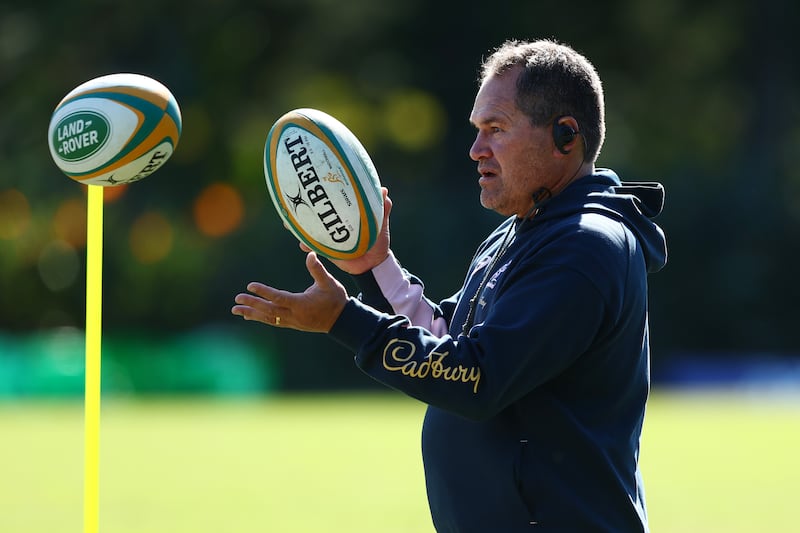Let’s play the Rugby Championship version of the Sesame Street game, One of these things is not like the other.
For all of you who believe that Mr Aloysius Snuffleupagus is not a figment of Big Bird’s imagination, feel free to singalong, as we try to figure out which is the odd one out between Pumas, Wallabies, Springboks and the registered trade mark of the NZRFU, which is in fact the colour black.
Now, be careful, there is a trick in there ...
To all the tin lids (kids) out there who picked the colour black ... a good try, but you are wrong. Rugby teaches us that we can’t win every day. So suck it up, build a bridge and get over it.
Malachy Clerkin: Gianni Infantino inventing the Fifa Peace Prize for Trump is humiliating all round
Even in their darkest moments, Cork City can surprise both their supporters and themselves
‘The sessions are like a maths exam’: Managing the club-intercounty training balance
Kelly Brady named Sportswoman of the Month for October
The trick was we are not talking about animals but rather the national rugby team of Australia, the Wallabies, because they are the only rugby nation in the world that has had to fight for survival since 1908 against Rugby League. A giant, hybrid, apex rugby predator.
Australia has 16 professional rugby league franchises that stretch from Townsville in the far north to Melbourne in the deep south. Rugby has only four professional teams across a country not much smaller than the United States.
Read more
[ Matt Williams: Here’s how rugby league can save shambles at scrum time in unionOpens in new window ]
[ Matt Williams: Who would be a coach? You would have to be madOpens in new window ]
However, on the international stage, those tables are turned. While the Rugby League’s World Cup will be held in the UK this October and Ireland will be proudly represented by passionate players from across the Irish diaspora, league cannot match rugby’s international traditions.
Supporters of sports like AFL and Rugby League in Australia do not follow rugby, but they do cheer for the Wallabies. In the past, the Wallabies’ spectacular successes empowered domestic rugby to hang on and keep the giant league clubs at bay.
When Jonny Wilkinson’s drop goal glided between the posts to snatch the 2003 World Cup final in Sydney against the Wallabies, it was the first rider of a seemingly apocalyptic series of disasters that were to smash into the game in Australia.
Across the next two decades, a litany of disastrous senior leadership appointments and horrific decisions squandered away the tens of millions of dollars RWC 03 had earned. Mean and ignorant policy decisions abandoned the junior grassroots of the game.
Multiple warnings from leading rugby luminaries across the community were repeatedly ignored as participation numbers in the men’s 15-a-side game haemorrhaged, TV viewing audiences evaporated, while crowds at Super Rugby and international matches plummeted.
Winning the William Webb Ellis Trophy became a quixotic dream and the Bledisloe Cup was granted a New Zealand passport.

Multiple leadership teams at Rugby Australia refused to address the truths that all in the local rugby community could see. Rugby in Oz was gravely ill.
The last rider of the Australian rugby apocalypse was the pandemic. It engulfed Australian rugby like a raging bush fire, exposing a financial crisis so brutal that it drove Rugby Australia (RA) to the very brink of bankruptcy and oblivion.
Australian rugby was not on its knees, it was prone on the canvas.
In the depths of the crisis, the old leadership was finally jettisoned. Then the former Wallaby great, Paul McLean, stepped in to take control as interim chairman of RA, alongside a highly trusted, long-term administrator, Rob Clarke, who became the interim chief executive.
Those of us who knew both Paul and Rob understood there were no better people to lead in the crisis. Paul has impeccable integrity and a life of dedication to Australian rugby.
[ Rugby hemispheres set on collision course over the 20-minute red cardOpens in new window ]
The community embraced Rob Clarke’s quiet honesty as he calmly explained to the world the catastrophe Australian rugby was facing.
McLean and Clarke somehow weathered RA’s brutal financial storm as they also commenced the process of replacing themselves with two excellent appointments. Andy Marinos became chief executive and Hamish McLennan was appointed as chairman.
As I have told you many times in the past, champions get up when they can’t. Like Australian forests after a bush fire, miraculously Australian rugby has began to regrow.
Since those horrible days, RA has been awarded the rights to host the men’s World Cup in 2027 and the Women’s tournament in 2029.
Defying conventional wisdom, RA dumped 25 years of having the game behind a paywall and returned all their matches back to free-to-air TV. Rugby’s ratings have exploded, as have bums on seats at Super Rugby and international matches.
[ Transgender players blocked from competing in women’s rugby union and leagueOpens in new window ]
By 2030 RA will be singing Sydney’s own ACDC’s, Back in Black, as their finances will be out of the red.
It has been my experience that boardroom leadership, good and bad, has a direct effect on the performances of the team.
This season the Brumbies have had a stellar season and after several disastrous years the Waratahs produced some gutsy wins.

The crucial aspect of the Wallabies’ performances under the leadership of their New Zealand-born coach Dave Rennie, is that Michael Hooper and his team-mates are giving every atom of their being to their gold jersey. In old money, they are trying their guts out.
This is not the most talented set of players to have pulled on the gold jersey but as Wallabies, they are giving their absolute maximum.
No one can ask more of a player than to give their best. That does not mean the Wallabies will be quickly returning to the great days of the 80s, 90s and 00s. Far from it.
As their Rugby Championship kicks off this weekend in Argentina, the Wallabies have two big issues.
Firstly they have a lack of world class players in several key areas and many players who could be selected are ineligible under RA rules as they are playing in Europe or Japan.
What is clear is that this group of Wallabies understand their responsibilities as stewards of the historic wattle green and gold jersey
The big issue for the XV who are on the field is that as individuals they are making an ocean of unforced errors.
As we witnessed last November against Scotland and in the recent series against England, Wallaby errors are handing the opposition far too many points in penalty goals. As it stands the Wallabies are defeating themselves.
Unless this self harm is rapidly changed Australia will not have enough to threaten the power of the Springboks or New Zealand.
What the Wallabies can produce over the next two weekends should make for entertaining contests against the Pumas. The fact that former Wallaby coach Michael Cheika is now leading the Pumas, who recently played some exciting rugby against Scotland, is an added spice.
What is clear is that this group of Wallabies understand their responsibilities as stewards of the historic wattle green and gold jersey.
Their mission is to grow their performances and pass that legacy on to the next generation in a better state than they received it. It is a mission that this team are currently on track to accomplish.

















